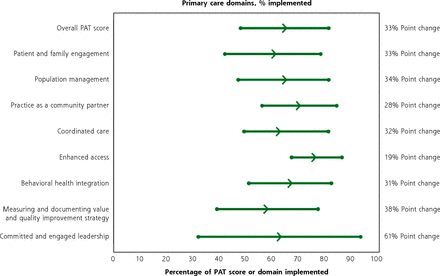To provide insight on how ambulatory care practices can reduce emergency department (ED) visits, we studied changes in Medicare ED visits for primary and specialty care practices in the Transforming Clinical Practice Initiative. We compared practices that transformed more vs less during the 6-year period ending in 2021 (3,773 practices). Using data from a practice transformation assessment tool completed at multiple intervals, we found improvement in the transformation score was associated with reduced ED visits by 6% and 4% for primary and specialty care practices, respectively, 3 to 4 years after first assessment. Transformation in 5 of 8 domains contributed to reduced ED visits.
Key words:INTRODUCTIONThe Transforming Clinical Practice Initiative (TCPI) was a 4-year national, voluntary, collaborative, peer-based learning initiative to improve quality of care and prepare ambulatory care practices of all specialties to succeed under value-based payment. Supporting practices through September 2019, the Centers for Medicare & Medicaid Services (CMS) disseminated a TCPI Change Package1 to help guide practices’ transformation progress. The Change Package is somewhat similar to medical home criteria for primary care practices and includes adapted strategies for specialty care practices. An accompanying instrument, the Practice Assessment Tool (PAT), measured practices’ progress on the Change Package at multiple points in time throughout the model. TCPI funded organizations known as Practice Transformation Networks (PTNs) and Support and Alignment Networks (SANs) to recruit practices and help them in implementing the Change Package (see Supplemental Appendix 1 for more information).
Prior research on other programs shows primary care practice transformation initiatives have had small associations with reduced acute care use, including emergency department (ED) visits.2-7 To our knowledge, it is unknown whether similar relationships hold for a broad set of specialty care practices that undertake change. Further, there has been little research on exactly which transformation activities are most effective. In one of the first public studies of TCPI, we examine whether 8 domains of TCPI practice transformation with theoretical potential to reduce ED visits were associated with changes in ED visits in primary and specialty care practices (Table 1).
Table 1.Relationship Between TCPI Practice Progress in Transformation and Changes in ED Visits for Medicare FFS Beneficiaries in the 2 Follow-Up Years
METHODSWe compared changes in rates of ED visits (not resulting in admission) per 1,000 Medicare beneficiaries for TCPI practices with more transformation measured in the PAT to those with less transformation. The 3,773 TCPI practices in the analysis served over 3.8 million Medicare fee-for-service (FFS) beneficiaries.
The PAT measured practices’ progress in implementing the Change Package. The PAT was typically administered by the PTN that had recruited the practice or a partnered organization and scored practices from 0-3 on 27 primary care and 22 specialty care milestones across 8 domains (Supplemental Appendix 2). To measure transformation progress, we focused on changes in the PAT score between a practice’s first and last PAT, where PAT score is the sum of the milestone-specific PAT score, expressed as a percentage of the maximum possible score.
We analyzed the change in practices’ FFS Medicare beneficiaries’ claims-based ED visit rate between baseline and follow-up. Baseline was a year-long period before first PAT, no earlier than April 2015. Follow-up years 1 and 2 were defined as the 2 consecutive years beginning 2 quarters after the last PAT, ending by September 2021. We studied ED visits not resulting in hospitalization, excluding those for COVID-19.
We used linear regression to estimate associations between the change in practices’ mean number of ED visits and practices’ percentage-point change in the overall PAT (or domain) score, controlling for first PAT scores; baseline ED rates; and characteristics of attributed Medicare beneficiaries (including COVID-19 diagnoses), practices, and markets (Supplemental Appendix 3, including Supplemental Tables 5-7 detail the estimation approach and control variables). Estimates are expressed in terms of a 40-percentage point improvement in practice transformation (an ambitious but attainable amount of change). We used 2-sided P values and considered results statistically significant at P < 0.10. We guarded against false positives by examining the magnitude of the estimates and the patterns of findings across practice groups and follow-up years.
RESULTSPrimary and specialty care practices in TCPI made considerable progress in implementing the Change Package and made improvements in all domains (Figure 1).



 Figure 1.
Figure 1. Progress on implementing the TCPI Change Package between the first and last PAT by practice type and PAT domain.
PAT = practice assessment tool; TCPI = Transforming Clinical Practice Initiative.
Note: Source is authors’ analysis of PAT data.
We found that a 40-percentage point improvement in the overall PAT was associated with a 6% and 4% reduction in ED visits by follow-up year 2 for primary and specialty care practices, respectively (Table 1). This translates into reductions of 31 and 19 ED visits per 1,000 beneficiaries per year, respectively. There were favorable associations between changes in ED visits and 5 domains for primary care practices: population management, measuring and documenting value and quality improvement (QI) strategy, behavioral health integration, coordinated care, and enhanced access, and 2 domains for specialty care practices: population management and enhanced access. The favorable associations were concentrated among practices that already made transformation progress before their first PAT and those with higher baseline ED rates (Supplemental Appendix 4, including Supplemental Tables 8-10 provide additional results).
DISCUSSIONPractice transformation took time—in our sample at least 3 to 4 years—to start being associated with reduced ED visits, a finding aligned with prior literature.7 Multiple domains of change were associated with reduced ED visits, suggesting broad-based transformation may be a better strategy than targeted improvement to reduce ED visits, especially with persistent effort over several years.
That we found stronger associations for primary care practices may reflect that the broader nature of their care offers more opportunity to reduce ED visits. The favorable findings for practices that started transformation earlier could reflect a more supportive culture of engagement with change, whereas practices with less supportive cultures may have reverted back to business as usual after their final PAT.
Overall, the results support CMS’s belief that the changes TCPI sought from practices are meaningfully associated with reduced ED visits, which are costly. If a 6% reduction in ED visits could be achieved nationally, Medicare could save up to $1.38 billion annually, less the cost of implementing TCPI, given that ED visits for Medicare patients totaled $23 billion in 2017.8
Our findings should not be interpreted as a causal impact of TCPI (there were no comparable PAT data for a comparison group). Despite a rich set of control variables, unobserved practice characteristics may still be correlated both with progress on transformation and with ED rates. Practices in our analytic sample might also differ from other TCPI practices, such as those with incomplete PAT data, or practices that did not participate in TCPI, in ways that affect ED visits, limiting generalizability of the findings. Future research should consider rigorously validating the PAT and studying outcomes beyond the ED.
The results of our study are important as they provide insight into which activities might help lower ED visits in the broad Medicare population. Future initiatives targeting reduced acute care use might consider the transformation activities included in the TCPI Change Package.
Received for publication September 9, 2023.Revision received January 16, 2024.Accepted for publication March 4, 2024.© 2024 Annals of Family Medicine, Inc.
留言 (0)